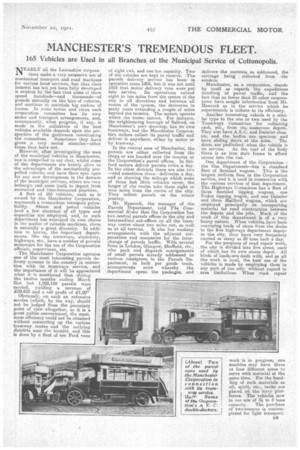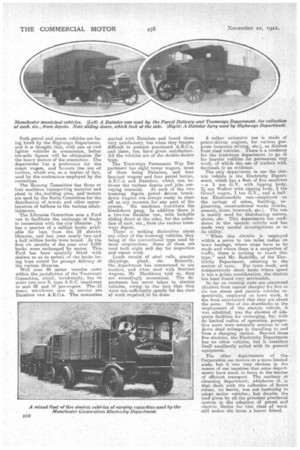MANCHESTER'S TREMENDOUS FLEET.
Page 9

Page 10

If you've noticed an error in this article please click here to report it so we can fix it.
165 Vehicles are Used in all Branches of the Municipal Service of Cottonopolis.
NEARLY all the Lancashire corporations make a very extensive use of 'mechanical transport and road machines for various locals services, but that their interest has not yet been fully developed is evident by• the fact that some of them spend hundreds—and thousands—of pounds annually on the hire of vehicles, and continue to maintain big stables of horses. In sonic towns and cities each corporation committee has its own motor and transport arrangements, and, consequently, what progress, if any, is made in the utilization of the best vehicles available depends upon the perspective of the gentlemen constituting the committee. Sometimes they have given a very useful stimulus—other times they have not.
However, after investigating the aises of the municipal vehicles in Manchester, one is compelled to say that, whilst some of the, departments are keenly alive to the advantages ofthe mechanically propelled vehicles and have their eyes open for any new development in the domain of the municipal services, others are very lethargic and seem loath to depart from encrusted and time-honoured practices. A fleet of 165 vehicles, such as is owned by the Manchester Corporation, represents a tremendous transport potentiality. Steam and petrol vehicles and a few electrics) of all types and capacities aro employed, and, as each department has exercised its own choice in the matter of suitable machines, there is naturally a great diversity. In addition to lorries, the important departments, like the tramways, electricity, highways, etc., have a number of private motorcars for the use of the Corporation officials, supervisors, etc. The Manchester Corporation operates one of the most interesting parcels delivery systems in the country in connection with its tramways service,-and the importance of it will be appreciated when it is mentioned that -during the twelve months ending March 31st last 1,022,158 parcels were carried, yielding a revenue of 229,603 and a net profit of 21,00' ObvicrusIS7, on such an extensive service (which, by the way, should not be judged from the pecuniary point of viewaltogether, as it is a great public convenience), the maximum efficiency could not be obtained without connecting up the various tramway routes and the outlying districts near the termini, and this is done by a fleet of ten Ford vans
of eight cwt. and one'ton capacity. Two of the vehicles are kept in reserve. The parcels delivery service has been in operation since 1905, but it Was not until 1815 that motor delivery vans were put into service. Its operations extend eight to ten miles from the centre of the city in all directions and between all routes of the 'system, the deliveries in many cases extending a couple of miles beyond the termini. The motors operate where the trams cannot. For instance, the neighbouring borough of -Salford, on Manchester's y.ery doorstep, has its own tramways, but the Manchester Corporation motors collect its parcel traffic and deliver it anywhere, either by motor or by tramway.
In the central area of Manchester, the. parcels are either collected fromthe shops or are handed over the counter at the Corporation's parcel offices. In Salford motors deliver parcels twice a day. In the other districts there are also two —and sometimes three—deliveries a day, and as showing the mileage which some of these fast little vehicles cover, the . longer of the routes take them eight or nine miles from the centre of the city. They collect parcels on the return journey. '
Mr. Hancock, the manager of the Parcels Department, told The Commercial Motor that the Corporation has two central parcels offices in the city and intermediate sub-offices on all the tramway routes about two miles out, as well as at all termini. It also has working arrangements with the adjacent corporations and companies for the interchange of parcels traffic. With several firms in London Glasgow, Sheffield, etc., who pack and dispatch consignments of small parcels already addressed to various consignees to 'the Parcels Department, in bulk per goods train, arrangements exist whereby the .department opens the packages, and
delivers the contents as addressed, the carriage being collected from Ails senders.
Manchester, as a corporation, stands by itself as regards the expeditious handling of parcel traffic, and' the fact that no fewer than 25 other corporations have sought information' from Mr. Hancock as to the service which he superintends is tribute to its efficiency.
Another interesting vehicle is a similar type to the one or two used by the Tramways Committee for collecting cash, etc.,• from the. 'numerous depots. They also have A.E.C. and Daimler chasais, andthe. bodies • are spacious and have sliding doorsat the side's.The doers are padlocked when the vehicle is on service. At the rear of the body there is an iron stair frame to afford access into the. van.
One department of the Corporation— the -Ga,s Depaitment--hae -a standard
fleet of Sentinel wagons. This is the • largest uniform fleet: in the Corporation service, and it is used in connection with the various services of that department: The Highways Committee has a fleet of • three Sentinel tipping wagons, one • Foden tipping wagon, and one Daimler and three Hallford wagons, which are employed principally on transporting material for road construction between the depots and the jobs, Much of the work of this department is of a very heavy nature. When vehicles, have been conveying loads of stone from the docks to the five highways department depots in the city, they have very frequently carried as many as 30 tons each a day.
• For the purposes of road repair work, the city is divided into five areas, each of which has its own stores depot. All kinds of loadssaredealt with, and as all the work is local, the: best' use of the vehicles is made by employing them in any part of the city, without regard to area limitations. When road repair
Both petrol and steam vehicles are being hired by the Highways Department, and it is thought, that, with one or.twit lighter vehicles in commission, better ton-mile figures will be obtainable for the heavy motors of the committee.. The department has .a preference for the steam wagon, and favours the. use trailers, which are, as •a matter of fact, used by the contractors employed by the committee.
The Housing Committee has three or four machines transporting material and plant to the; building sites, and motors are used by the Baths Committee for the distribution of ,towels and other appurtenances of bather% to the ■rarious.estabs lishments.
The Libraries *Committee uses a Ford van to facilitate the exchange of books in connection with the city libraries. :It has a quarter of a million books available for loan from the 23 district libraries, and last year nearly two. and a.half million books were issued. ',In the first six months of the year over 2,000 books were:exchanged by motor. This Ford has been specially fitted with shelves so as to permit ssf the books be-. ing kept sorted for prompt delivery at the various libraries.
Well over 40 motor vemcles come within the jurisdiction of the Tramways Committee, which, incidentally, has on order two now S. type A.E C. onsaibuses to seat 52 and 54 passengers. Tbo-.13 main' omnibuses now in service are Daimlers and A.E.O.s. The committee
started with Daimlers and found them very satisfactory, but when they became difficult to procure purchased A.E.C.s, and these, too, have given satisfaction. All the vehicles are of the double-decker type. The Tramways Permanent Way Des partment has eight tower wagons, most of them being Daimlers, and four Sentinel wagons and four petrol lorries, A.E.C.ss and Daimlers, which run between the various depots and jobs conveying material. At each of the two tramway depots petrol driven breakdown wagons are always ready to start off at any moment, for any part of the system. Six machines constitute the breakdown gang. In addition there is a two-ton Daimler van, with lockable sliding doors at the sides, for the collection of cash, etc., from the various tramways depots. _There is nothing distinctive about any other of the tramwag vehicles, they being of the conventional type used by most corporations. Some of them are used both night and day for inspection and repair work. 'Loads consist of steel rails, granite chippings, plant, etc. Recently, the department has commenced to use trailers, and when used with Sentinel wagons, Mr Blackburn told us, they are exceedingly economical. The department has never taken to electric vehicle,s, owing to the fact, that they were not sufficiently speedy for the class ef work required.te he done.
A rather extensive use is made of petrol-driven engines, fur various Rurposes (concrete mixing, etc.), as distinct from road vehicles. There is a tendency for the tramways department to go in for heavier vehicles for permanent way work, of which the use of trailers with Sentinels is an evidence.
The only department to use the electric vehicle is the Electricity Department, which has a fleet of five machines —a 5 ton G.V. with tipping body, 3L ton Walker with tipping body, 2 ton Orwell wagon, I ton G.V., and a halfton Electrornobile van—employed OD the cartage of ashes, building, engineering, constructional works (bricks, cement, stone, ironwork, etc.). The van is mainly used for distributing meters, stores, etc. This department has confidence in the electric vehicle and has made very careful investigations as to its utility.
" When the electric is employed within a seven to ten miles radius on town haulage, where steps have to be made and where there is a congestion of traffic, there is nothing to touch this type," said Mr. Radcliffe, of the Electricity Department, referring to the matter of costs. For town work, and comparatively short hauls -where speed is not a prime consideration, the electric has been found very serviceable.
So far as running costs are concerned (distinct from capital charges) for five to six ton steam and electric vehicles respectively, employed on town work, it, has been ascertained that they are about the same. One of the drawbacks to the employment of the electric vehicle, it was admitted, was the absence of adequate facilities for recharging, for, with its limited radius of operation, prospective users were naturally anxious to cut down dead mileage in travelling to and from a charging station. Beyond these five electrics, the Electricity Department has no other vehicles, but it. considers itself excellently suited with its present equipment.
The other departments of the Corporation use motors on a more limited scale, but it. was very obvious in the course of our inquiries that sdme departments have much to learn in the matter of efficient transport. The sanitary or cleansing department, whichever it is that deals with the collection of house refuse, we learnt, was not hastening to adopt motor vehicles; but despite the lead given by all the principal provincial centres in the adoption of petrol and electric lorries for this class of work still makes the horse a bosom friend.








































